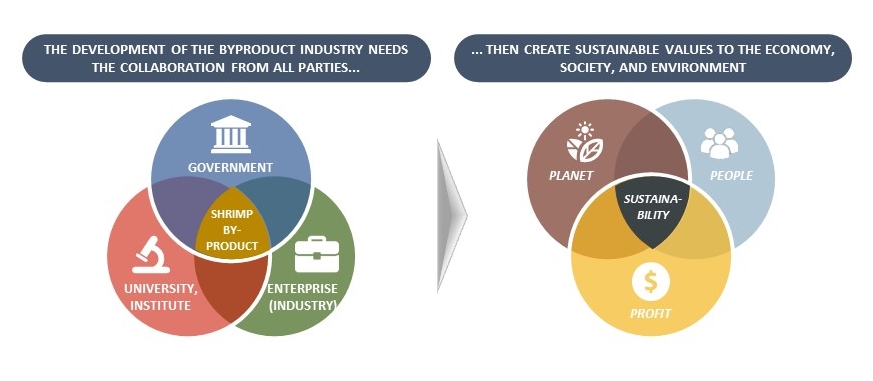Earlier this week, VNF had the honour to welcome Mr. Huynh Thanh Dat – The Minister of Science and Technology and the Assembly from Ministry of Science and Technology and many universities in Ho Chi Minh city: Vietnam National University (VNU HCMC), Ho Chi Minh City University of Technology (HCMUT), and Ho Chi Minh City International University (IU – VNU HCMC). Another major milestone in VNF’s development and a memorable event to end 2021!
During the meeting, the Minister, the assembly and VNF discussed about developing the shrimp byproduct industry and also product applications that can contribute to national economic development, particularly agriculture sector, as the world is moving towards sustainable development under climate change pressure.


Vietnam Agriculture – Industry of high potential development yet with unsolved issues
As an agricultural country, Vietnam has been focusing on developing key agricultural produces and has attained certain achievements in the global market: amongst top rice, coffee, shrimp and animal feed, etc. exporter. Nevertheless, Vietnam still has to work on several issues in order to go further in its sustainable development journey and to adapt to the climate change while managing to increase the output value and quality:
- Input: heavy dependence on imported materials (especially crude protein), therefore little control over the supply, lacking competitive advantages [1] and threatening national food security
- Farming and processing: overuse of antibiotics, pesticides, fertilizers yet with low efficiency [2][3][4], lowering the value and therefore the reputation of Vietnam agricultural produces in the international market;
- Agricultural by-products: in large volume and keep increasing, if not handled properly, it will lead to environmental pollution and a waste of resources [5].
These problems will hinder the development of the industry, leave negative impacts on consumers’ health, and lower the competitiveness of products of Vietnam if no prompt actions are to be taken.
Vietnam agricultural industry therefore needs sustainable solutions
The above-mentioned problems seem to be unconnected, yet can be solved together in one holistic solution: “Developing shrimp byproduct industry in which green approaches are applied to recover nutrients and turn into novel and high value products”
Worldwide with the increasingly depleting natural resources, “Upcycling byproduct” is no longer a new concept. Many developed countries have utilized byproducts as a new source of raw materials to reserve natural resources and mitigate climate change consequences for a greener & more sustainable development.
In Vietnam, the government aims for the national shrimp industry to become the key economic sector (Vietnam shrimp industry currently ranks 3rd globally in export value). With the development of shrimp industry, SHRIMP BY-PRODUCT – the weakest link in shrimp value chain at the moment – needs to be better handled. From this very resource with the proper technology, we can develop a wide range of products such as biopolymer (Chitosan, Chitin, Oligochitosan,..), peptides, natural antioxidants (Astaxanthin)… that can serve to solve the above-mentioned issues.


According to scientists and professors present at the meeting, Chitosan and Peptides are highly potential. These products can be used not only in agriculture (animal husbandry and horticulture, etc.) but also in Food ingredients, Functional Food, Pharmaceuticals and Medical industry with more premium applications. That VNF is providing these biomaterials of high quality, at competitive cost and in stable supply, in a way, is helping scientists to facilitate their application development and commercialization. These two products and others made from shrimp byproduct can offer and contribute new values to the shrimp industry and also many other. That is Sustainable & Circular Economy!

Having listened to many presentations, Mr. Huynh Thanh Dat – the Minister of Science and Technology – shared his belief in the value and potential development of the shrimp byproduct industry. This so-called “waste burden” with the right valorization technology and mindset will be the resources of the future. He especially put great emphasis on the importance of science and technology and the national resources mobilization (The triple helix model) in finding the solution for the industry, thereby creating values and contributing to the environment & society.

VNF strongly believes in the role of Triplex Helix: University – Industry – Government in our mission to valorize shrimp byproducts into new and valuable solutions for Vietnam. With the involvement and support from the Government and Universities/Institutes, this shrimp byproduct industry will be better geared up for success. Thereby, Vietnam will have more Vietnamese products made by Vietnamese people and Vietnam trademark will find its position in the world!

REFERENCE
[1] https://vneconomy.vn/san-xuat-thuc-an-chan-nuoi-lao-dao-vi-thieu-nguyen-lieu-646566.htm
[2] https://nhandan.vn/baothoinay-xahoi/nguy-co-tu-lam-dung-khang-sinh-trong-chan-nuoi-347549
[3] http://agro.gov.vn/vn/tID26555_Moi-nam-Viet-Nam-su-dung-100000-tan-thuoc-bao-ve-thuc-vat.html
[5] https://thuysanvietnam.com.vn/khong-the-mai-lang-phi-tai-nguyen/

